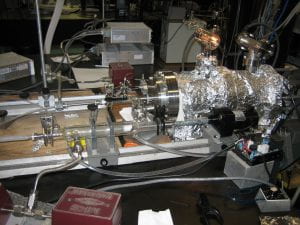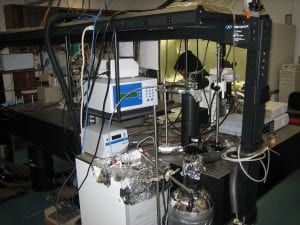In our group we address most of the research questions by experimental means. (Modeling studies are also part of our research endeavor, see, e.g., Springmann et al. 2009 and Kaiser et al. 2011). However, it is very common in our research to develop new experimental setups and instrumentation or set up instrumentation in the filed to inquire novel science. This involves knowledge of vacuum techniques, optics, technical drawings, electrical circuits, programming of instrument interface, and synthesis of species.
The following are examples of instrument and technique developments:
Multiphase Chemical Kinetics – Chemical Ionization Mass Spectrometer
We built a chemical ionization mass spectrometer for detection of inorganic trace gases using an Extrel Quadrupole as mass filter.
Ice Nucleation Experiments Coupled to Optical Microscope
Humidity- and temperature-controlled environmental cells to simulate ice cloud formation under realistic conditions coupled to optical microscopy.
1000 L Mesocosm Experiment
This homemade mesocosm system allows to simulate ocean water biological processes and sea spray aerosol generation over periods of weeks.
Airborne Air Quality Measurements
We developed an octocopter drone to perform airborne measurements of trace gases and collect particulate matter. Below a successful test flight at the Stony Brook University’s UAV test field. The drone is equipped with an instrument payload of 8 kg.






